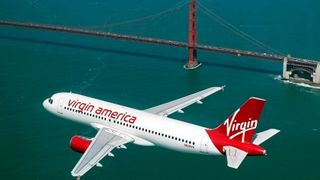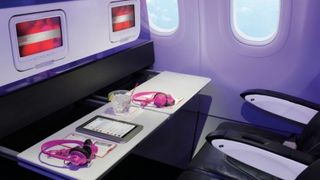In-flight Wi-Fi: where is it and why is it taking so long?
European airlines are lagging behind their American counterparts
How in-flight Wi-Fi works
In-flight Wi-Fi generally operates in one of two ways. What's dominating in North America is an Air to Ground (ATG) network, which is operated exclusively by GoGo in the US, Alaska and Canada. "Air to Ground solutions use a network of cellular towers on the ground to provide connectivity to an aircraft," says Penuela, calling it the smallest, lightest, and most economical connectivity solution. "It can be installed to an aircraft overnight."
"The second solution is satellite connectivity, which is used when coverage from ATG-based systems isn't possible, such as when the plane is flying over water. That explains why Europe is a more difficult market than North America. A satellite is placed on top of the aircraft, and the antenna pans and rotates in order to stay pointed at the directed satellites to bring passengers Wi-Fi access," says Penuela. "Satellite solutions generally deliver higher speeds, but are more expensive than ATG and require a longer installation time."

The capacity problem
Virgin America became the first airline to offer GoGo In-flight ATG Wi-Fi service on every flight back in 2009, and now claims peak speeds of 9.8 Mbps, three times that of six years ago.
Satellite speeds are consistently higher, though don't expect to stream movies as easily as on a domestic fibre service. "While in-flight Wi-Fi might not be able to provide the bandwidth to stream movies from services such as Netflix or Amazon Prime, it will be enough for customers to handle some emails, or social media," says Galindo. That's largely because of the fact that capacity must be shared between passengers.
"The capacity limits of the satellite solutions mean catering for a full flight of at least 200 people is still difficult," says Ferguson, whose own in-flight Wi-Fi testing has shown speeds to be variable, but always slow. You can email, surf and book a cab to pick you from the airport, but that's about it.
In-flight Wi-Fi = public Wi-Fi
There are always security risks associated with connecting to a public Wi-Fi network. "There is a possibility that the network can be compromised with malicious software that can infect your device, or that your emails or other personal information can be at risk," says Galindo.
It's also true that 'safe' is a relative concept, and applies to far more than your emails being hacked. "Wi-Fi in aircraft is a lot safer than the large volumes of flammable alcohol that most planes carry in the passenger cabin," suggests Ferguson, but he fears that concerns about people hacking the aircraft control systems are real. "If any Wi-Fi system installed is linked to control systems, and thus a potential target, that would be a very poor design," he says. "The best security would be physically separate networks."
Are you a pro? Subscribe to our newsletter
Sign up to the TechRadar Pro newsletter to get all the top news, opinion, features and guidance your business needs to succeed!

Real-time data saviour
There's also the smaller matter of Malaysian Airlines flight MH370, which vanished last year while en route from Kuala Lumpur to Beijing, with the loss of 239 people. As a result, aircraft are looking to send and receive more real-time data to keep in touch, which almost all airline passengers presumed they were already capable of. Flight MH370 suggested this wasn't the case at all.
"For some flights they are potentially in permanent contact now," says Ferguson, but he points out that unpredictable weather and intermittent satellite coverage means that Wi-Fi can easily be interrupted. "It is possible that in-flight data connections may not be 100% reliable."
For now, if you're on a transatlantic plane, you're on your own. "The next step for GoGo will be to not only provide passengers with connectivity and entertainment, but to provide operational solutions for the flight crew," says Penuela. "This includes connecting pilots through an electronic flight bag so they can get real-time data to improve flight safety and operate more efficiently, and connecting components on the aircraft like engines and other key hardware so they can be monitored instantaneously."
The technology still isn't perfected, the speeds are slow, and the business models unsure. While in-flight Wi-Fi is on the way, some say it may not reach maturity until 2020. Even then, Europeans will likely have to pay, though they will likely get a service which is superior to that in the US.
For now, seamless and high speed internet in the air across the globe is still a flight of fancy.
Jamie is a freelance tech, travel and space journalist based in the UK. He’s been writing regularly for Techradar since it was launched in 2008 and also writes regularly for Forbes, The Telegraph, the South China Morning Post, Sky & Telescope and the Sky At Night magazine as well as other Future titles T3, Digital Camera World, All About Space and Space.com. He also edits two of his own websites, TravGear.com and WhenIsTheNextEclipse.com that reflect his obsession with travel gear and solar eclipse travel. He is the author of A Stargazing Program For Beginners (Springer, 2015),

An incredible $100 billion bet to get rid of Nvidia dependence — tech experts reckon Microsoft will build a million-server strong data center that will primarily use critical inhouse components

HP launched a very promising ultra portable XPS13 killer laptop — the 1kg EliteBook 635 Aero G11 is only available in Japan with seemingly no plans for a global launch, but why?
Most Popular



